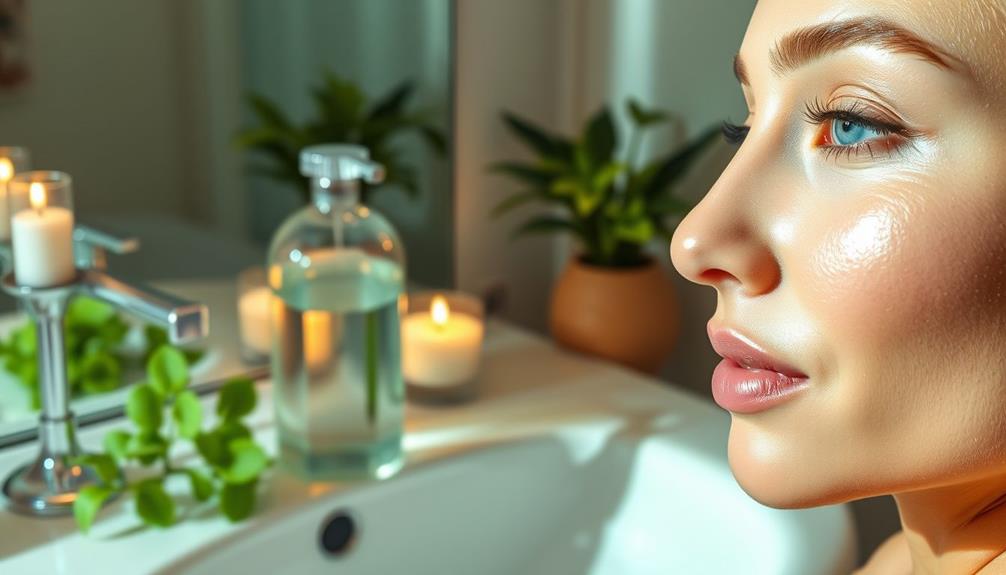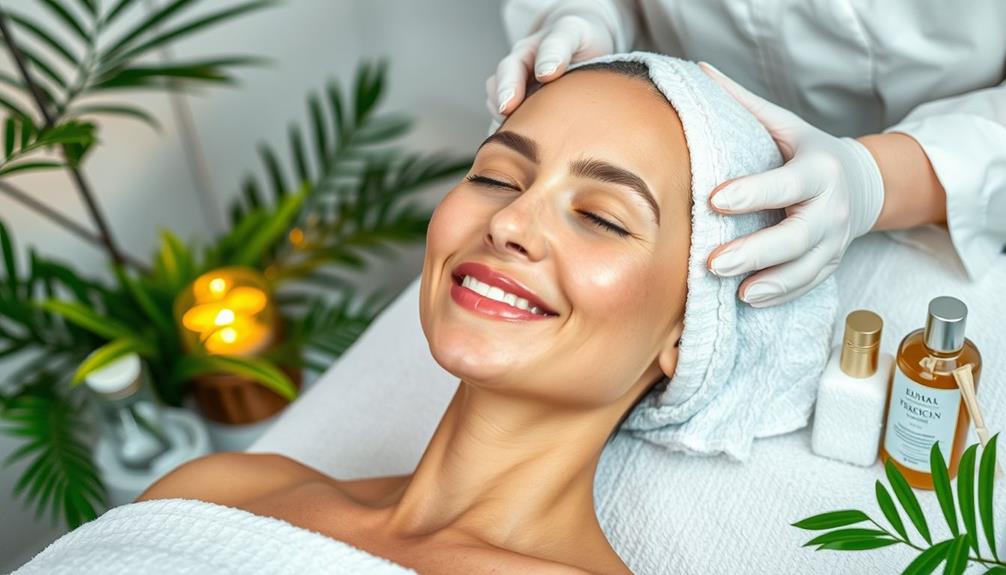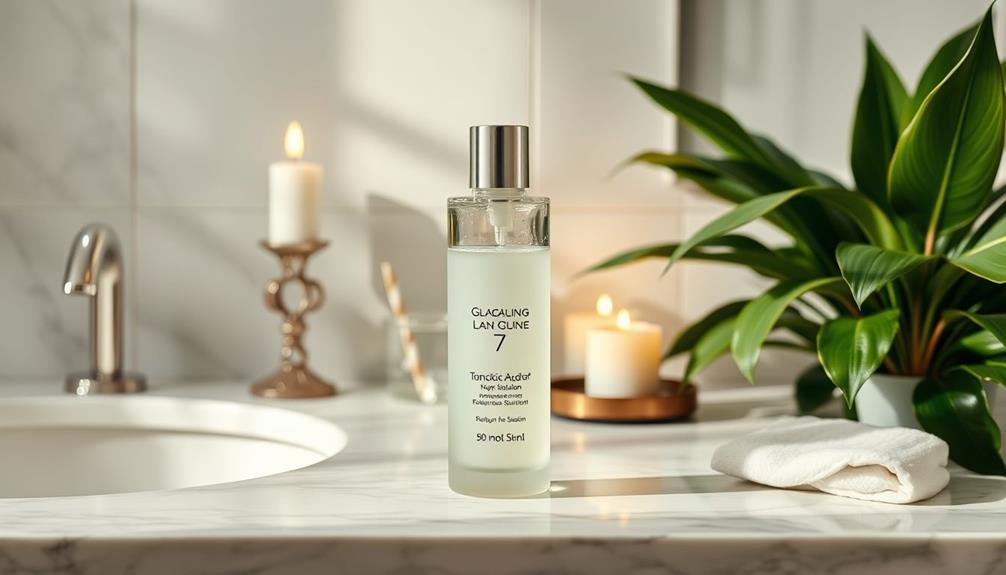Glycolic acid is a **strong exfoliant** that can totally change your skin. By **speeding up cell turnover**, you’ll see smoother skin with better texture and tone. This wonder ingredient can also help **fade dark spots** and unclog pores to keep acne at bay. Start with a lower concentration to prevent irritation. And don’t forget your sunscreen! There’s so much more to learn about how glycolic acid can improve your skin – keep exploring to uncover all its amazing benefits! See what a difference it can make for you!
Key Takeaways
- Glycolic acid promotes cell turnover, leading to a brighter and smoother complexion by exfoliating dead skin cells effectively.
- It stimulates collagen production, enhancing skin firmness and elasticity, which helps reduce fine lines and wrinkles.
- This acid helps fade dark spots and hyperpigmentation, making it beneficial for achieving an even skin tone.
- Glycolic acid unclogs pores, preventing acne breakouts, and is particularly effective for those with acne-prone skin.
Understanding Glycolic Acid

Glycolic acid, a powerful alpha-hydroxy acid derived from sugar cane, penetrates deeply to exfoliate your skin effectively. This chemical exfoliant works by breaking down the bonds between dead skin cells, allowing for faster cell turnover. As a result, you can expect to see improvements in your skin texture and tone.
Incorporating gentle skincare routines, akin to yoga for back pain relief, can also enhance your overall skin health.
When you incorporate glycolic acid into your routine, you're tackling a range of skin concerns. It's particularly effective in reducing the appearance of fine lines and hyperpigmentation, especially in photo-aged skin. If you struggle with acne, glycolic acid can help unclog pores, making it a valuable ally in acne prevention.
You'll find glycolic acid in various formulations, with over-the-counter products typically containing concentrations of 5% to 10%. For more dramatic results, consider professional treatments, which can utilize concentrations up to 70%.
However, always consult with a skincare professional before diving into higher concentrations to avoid irritation. Understanding how glycolic acid interacts with your skin sets the foundation for achieving a clearer, more radiant complexion.
Benefits for Skin
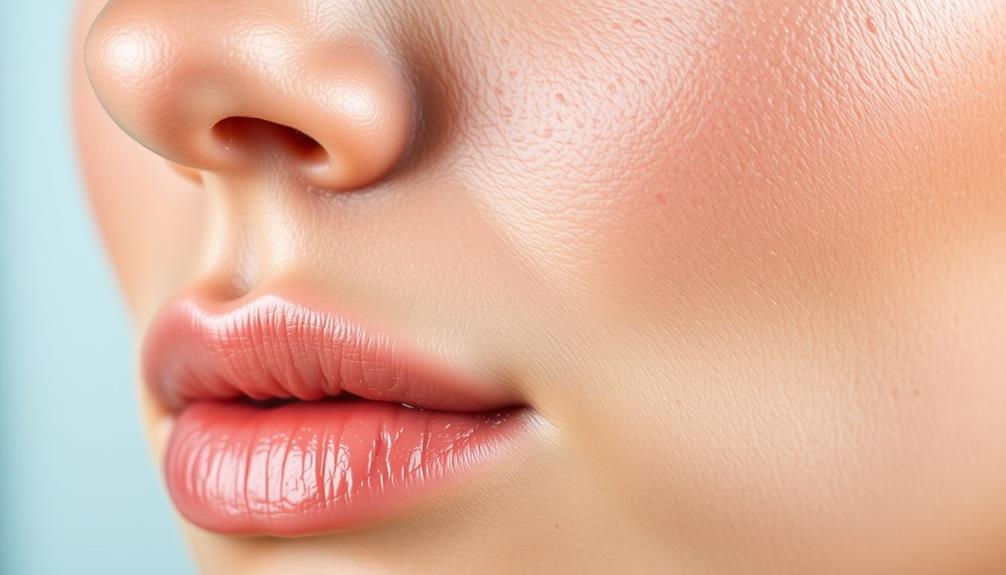
By accelerating cell turnover and enhancing hydration, glycolic acid offers numerous benefits that can transform your skin's appearance. Its powerful exfoliating properties dissolve the bonds between skin cells, resulting in a brighter, smoother complexion. This means you can say goodbye to dull skin and hello to a more radiant look.
Additionally, incorporating essential oils for overall wellness can complement the effects of glycolic acid, promoting a holistic approach to skincare.
Glycolic acid stimulates collagen production, which helps reduce fine lines and wrinkles while improving your skin's firmness and elasticity. If you're dealing with dark spots or hyperpigmentation, particularly from acne or sun damage, regular use of glycolic acid can help fade those imperfections through effective exfoliation and cell renewal.
Moreover, glycolic acid excels as an acne treatment. By unclogging pores and preventing breakouts, it's especially beneficial for those with acne-prone skin.
Plus, as a humectant, glycolic acid attracts moisture to your skin, promoting hydration and overall skin plumpness. Incorporating glycolic acid into your skincare routine can considerably improve skin texture and deliver a host of benefits that leave your skin looking and feeling its best.
Usage Guidelines
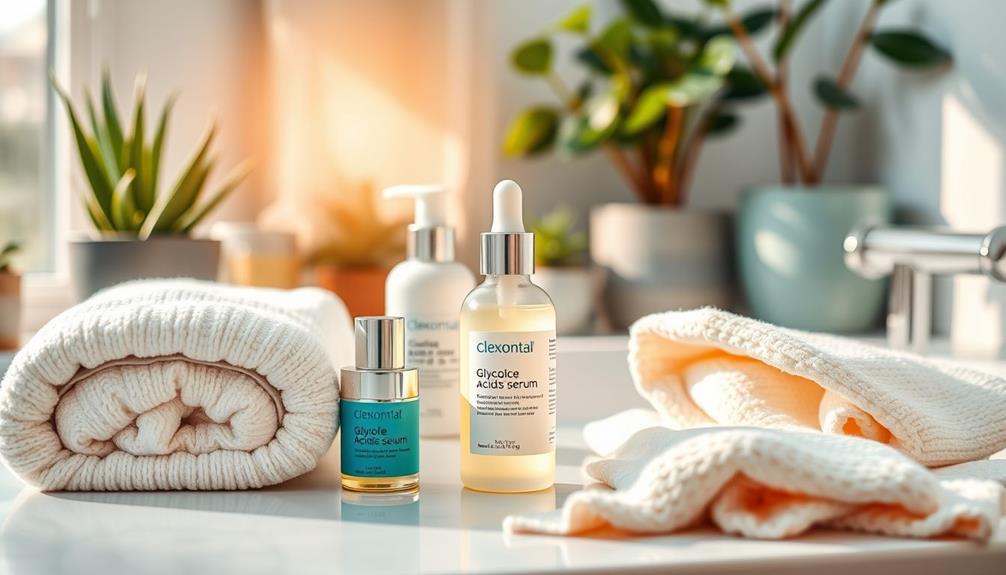
To maximize the benefits of glycolic acid while minimizing potential irritation, it's important to follow specific usage guidelines.
Start by using a low concentration (5-10%) and apply glycolic acid to clean, dry skin in the evening. For enhanced relaxation, consider incorporating aromatherapy techniques alongside your skincare routine.
Use a cotton pad or your fingertips, making sure to avoid sensitive areas like your eyes and lips for ideal absorption. It's wise to begin with application once or twice a week to let your skin adjust.
After applying glycolic acid, follow up with a good moisturizer to combat potential dryness. As your skin becomes accustomed, you can gradually increase the frequency of use based on your tolerance.
However, if you notice significant irritation, reduce usage or discontinue application altogether. Always remember to conduct a patch test on a small area of skin before full application to check for adverse reactions.
Also, keep in mind that glycolic acid can increase sun sensitivity. So, during the day, make sure to protect your skin by using a broad-spectrum sunscreen (SPF 30+).
Side Effects and Risks

When using glycolic acid, you might experience common irritation symptoms like redness, burning, or peeling, especially if your skin is sensitive.
It's important to incorporate a balanced diet to support skin health, as certain foods can enhance the effects of treatments like glycolic acid essential foods can boost the immune system against colds.
It's also vital to be aware of increased sun sensitivity, making daily sunscreen a must.
Additionally, overusing high concentrations can lead to hyperpigmentation, particularly in darker skin tones, so start low and monitor how your skin reacts.
Common Irritation Symptoms
Using glycolic acid can lead to common irritation symptoms like redness, burning, itching, and peeling, particularly for those with sensitive skin. It's important to monitor your skin's reaction when starting a glycolic acid regimen. If you notice severe skin irritation or allergic reactions, you should immediately discontinue use.
Here's a quick overview of potential irritation symptoms:
| Symptom | Description |
|---|---|
| Redness | Skin may appear flushed or inflamed. |
| Burning | A stinging sensation can occur. |
| Itching | You might feel an urge to scratch. |
While initial purging can happen as your skin adjusts, it usually resolves quickly. However, using high concentrations or over-applying glycolic acid can worsen irritation and lead to post-inflammatory hyperpigmentation, especially in darker skin tones.
To alleviate symptoms, consider using soothing products post-application. Always listen to your skin and adjust your glycolic acid use as necessary to maintain a healthy complexion. Remember, it's vital to prioritize your skin's health above all else!
Sun Sensitivity Concerns
How can glycolic acid impact your skin's sensitivity to sunlight? When you incorporate glycolic acid into your skincare routine, you may notice increased sun sensitivity. This means you're at a higher risk of skin irritation, such as redness and peeling, especially if you're exposed to the sun after application.
Additionally, using skincare patches can help target specific concerns like irritation and improve overall skin health, providing understanding skincare patches as a complementary treatment. To protect your skin, it's important to use broad-spectrum sunscreen (SPF 30+) daily. This is vital for preventing skin damage and reducing the likelihood of post-inflammatory hyperpigmentation, particularly if you have darker skin tones.
To minimize these risks, consider using glycolic acid products in the evening. This allows your skin to recover overnight while reducing exposure during peak sun hours (10 AM to 4 PM). By avoiding sun exposure during these times, you lower the chances of adverse reactions.
Hyperpigmentation Risks
Glycolic acid's exfoliating effects can heighten the risk of hyperpigmentation, particularly if irritation occurs, making it important to approach its use with caution.
If you have sensitive skin, you might be more susceptible to post-inflammatory hyperpigmentation (PIH) due to the potential irritation from glycolic acid. Regular hydration and balanced meals can enhance your skin's resilience, reducing the likelihood of irritation and subsequent hyperpigmentation managing daily headaches.
Overusing or applying high concentrations can lead to inflammation, exacerbating hyperpigmentation and causing darkening in affected areas.
To minimize these risks, start with lower concentrations of glycolic acid. Gradually increase the frequency of use as your skin builds tolerance. This method allows you to monitor how your skin reacts without overwhelming it.
Additionally, since glycolic acid makes your skin more sensitive to UV rays, applying broad-spectrum sunscreen daily is essential. This step helps protect against further hyperpigmentation and shields your skin from damage.
Choosing the Right Product

When you're choosing a glycolic acid product, concentration is key, so look for formulas between 5% and 10% for safe use at home.
Consider the type of formulation as well; leave-on products like serums tend to work better than cleansers or toners.
Don't forget to check for compatible ingredients that can enhance hydration and minimize irritation for your skin.
Concentration Matters
Choosing the right concentration of glycolic acid can make all the difference in achieving your desired skin results while minimizing irritation.
Over-the-counter products typically range from 5% to 10%, making them suitable for most users, especially those with sensitive skin. If you're just starting, it's wise to begin with the lowest concentration, around 5%, and gradually increase as your skin builds tolerance. This approach helps avoid adverse reactions and allows your skin to adapt without excessive irritation.
The pH level of glycolic acid products is also essential; aim for products with a pH around 4 for peak effectiveness.
Higher concentrations, often found in professional chemical peels administered by dermatologists, can yield dramatic results but require careful application and monitoring.
If you have specific skin concerns or conditions, verify that the concentration aligns with your skin type and needs.
Remember, while higher concentrations may seem appealing for quicker results, they can lead to increased sensitivity and irritation if not used properly.
Always read product labels carefully to choose wisely for your skin's health and beauty.
Formulation Types
Understanding the various formulation types of glycolic acid products is key to finding the right one for your skin needs.
These formulations include cleansers, toners, serums, creams, and masks, each designed to provide different benefits. Leave-on products, like serums and creams, generally yield better results due to prolonged contact with your skin.
When selecting a glycolic acid product, consider the concentrations available. For at-home use, concentrations typically range from 5% to 10%, while professional treatments can reach up to 70%. This allows for deeper exfoliation and more immediate results.
If you have oily skin, toners are often recommended for their lightweight application, while serums and creams suit dry or mature skin thanks to their hydrating properties.
Don't forget to check the pH level of the product. An ideal pH around 4 guarantees effective exfoliation while remaining gentle.
If you're new to glycolic acid, start with lower concentrations and gradually increase usage to monitor your skin's tolerance. This approach helps minimize the risk of irritation, making your journey to healthier skin smoother and more effective.
Ingredient Compatibility
To achieve the best results with glycolic acid, pair it with hydrating ingredients like hyaluronic acid and niacinamide for added moisture and to minimize irritation. Understanding ingredient compatibility is essential for a successful skincare routine. Here are some tips to keep in mind:
- Stick to Hydrating Ingredients: Use glycolic acid alongside moisturizers to maintain hydration and support your skin barrier.
- Avoid Strong Exfoliants: Don't combine glycolic acid with other potent exfoliants like salicylic acid or retinoids, as this can lead to excessive irritation.
- Watch the pH Level: Look for products with a pH around 4 to align with your skin's natural acidity, maximizing efficacy while reducing irritation risk.
- Start Slowly: Introduce glycolic acid in lower concentrations (around 5%) to assess your skin tolerance before increasing strength or frequency.
Combining Ingredients
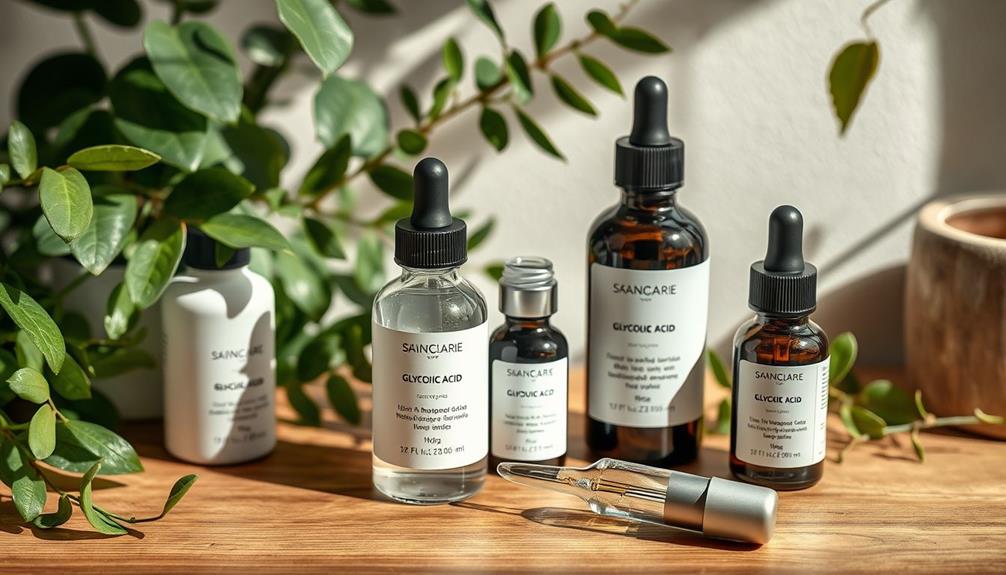
Combining glycolic acid with hydrating agents like hyaluronic acid and niacinamide can greatly boost moisture retention and minimize irritation. These ingredients work together to enhance your skin's hydration, ensuring that the exfoliating effects of glycolic acid don't compromise your skin barrier. Just remember, it's important to keep the pH level around 4 for ideal efficacy.
When you incorporate glycolic acid, you can also improve the effectiveness of other active ingredients, such as vitamin C. This combination enhances skin texture, allowing for better absorption of vitamin C and maximizing its benefits. However, you should avoid using glycolic acid with other potent exfoliants like retinoids or salicylic acid, as this can lead to excessive irritation.
Always perform a patch test before mixing glycolic acid with new ingredients to check for any adverse reactions. Different skin types might react differently, so monitoring your skin's response is vital.
Frequently Asked Questions
Do Dermatologists Recommend Glycolic Acid?
Yes, dermatologists recommend glycolic acid for its skin benefits. They often suggest starting with lower concentrations and gradually increasing use while emphasizing the importance of sunscreen to protect your skin from increased sun sensitivity.
What Does Glycolic Acid Do to the Skin?
Imagine your skin shedding its old layers like autumn leaves. Glycolic acid works wonders, exfoliating, boosting cell turnover, and promoting collagen. You'll notice smoother texture, reduced wrinkles, and a radiant glow with regular use.
Is Glycolic Acid Good for Aging Skin?
Yes, glycolic acid's excellent for aging skin. It boosts collagen production, enhances moisture retention, and promotes cell turnover. You'll notice improved firmness, reduced fine lines, and a more even skin tone with regular use.
Do You Really Need Glycolic Acid?
Do you want glowing, youthful skin? You might need glycolic acid! It exfoliates, brightens, and fights aging. If you're looking for smoother texture and fewer breakouts, incorporating it could be a game changer for you.
Conclusion
Incorporating glycolic acid into your skincare routine can be a game changer for your complexion. It gently exfoliates, revealing brighter, smoother skin beneath.
Just remember to start slow and listen to your skin, as too much can lead to irritation.
Choose the right product for your needs, and don't hesitate to mix it with complementary ingredients.
With a little patience and care, you'll be on your way to glowing skin that feels as fresh as a morning dew.


